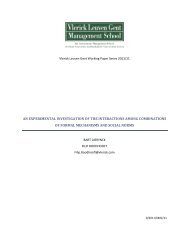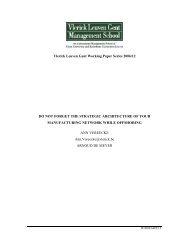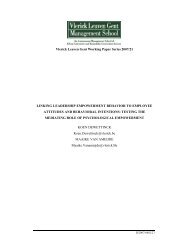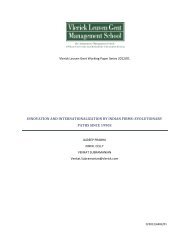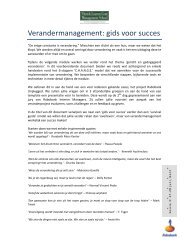Vlerick Leuven Gent Working Paper Series 2007/03 ... - Vlerick Public
Vlerick Leuven Gent Working Paper Series 2007/03 ... - Vlerick Public
Vlerick Leuven Gent Working Paper Series 2007/03 ... - Vlerick Public
Create successful ePaper yourself
Turn your PDF publications into a flip-book with our unique Google optimized e-Paper software.
In the next sections, we elaborate the indirect route by proposing three group process<br />
variables that will significantly influence the task performance of boards: cohesiveness,<br />
debate and conflict norms. Moreover, we capture them in a set of propositions.<br />
Cohesiveness and debate as intervening variables<br />
Despite of certain distinctive characteristics, boards of directors are, like top<br />
management teams, confronted with complex ambiguous tasks. Much of the work that boards<br />
of directors must do in order to produce effective outcomes involves cooperative decisionmaking<br />
and joint efforts. Board members are required to work together by mutual interaction,<br />
sharing information, resources and decisions. In this respect, the board of directors is<br />
considered to be a collegial body and only if board members coalesced into a group collective<br />
judgment can emerge (Charan, 1998). However, it is only the last decade that scholars began<br />
suggesting that the board should transform itself from a loose aggregation of individuals into<br />
an effective team (for example, Nadler, 2006 and 2004; Carter and Lorsch, 2004; Conger<br />
et.al., 2001). For boards of directors becoming a team, who operates collegial, we argue that a<br />
minimum degree of cohesion among the board members is required. Our view that cohesion<br />
aids collaboration and communication among board members, and as such influences<br />
performance outcomes, is also suggested and reinforced by research on other teams.<br />
Organizational demography literature has emphasised cohesiveness as a potential intervening<br />
construct and it is one of the most extensively studied variables in group settings<br />
(Bettenhausen, 1991; Williams and O’Reilly, 1998). Group cohesiveness is defined as “the<br />
degree to which the members of the group are attracted to each other and are motivated to<br />
stay in the group” (Shaw 1976:197). The concept is affective in nature and is characterised by<br />
a sense of connectedness. In particular, cohesiveness is considered to play a vital role in any<br />
exchange relationship (Austin, 1997) and it can be argued that it also has relevance in the<br />
context of boards of directors. To the extent board members like each other and like the<br />
group, they can be expected to interact and integrate more easily. Moreover, qualitative<br />
research on boards of directors (e.g. Van den Berghe and Levrau, 2004; Finkelstein and<br />
Mooney (20<strong>03</strong>)) has revealed that directors value the chemistry of the board and the team<br />
spirit of their colleagues as important elements of board effectiveness. Ideas as “team spirit”<br />
and “teamwork” have been linked to the concept of cohesiveness (Seashore, 1977). Lastly, the<br />
board model put forward by Forbes and Milliken (1999) has also suggested that cohesiveness<br />
may exert an influence on the task performance of boards of directors.<br />
14



